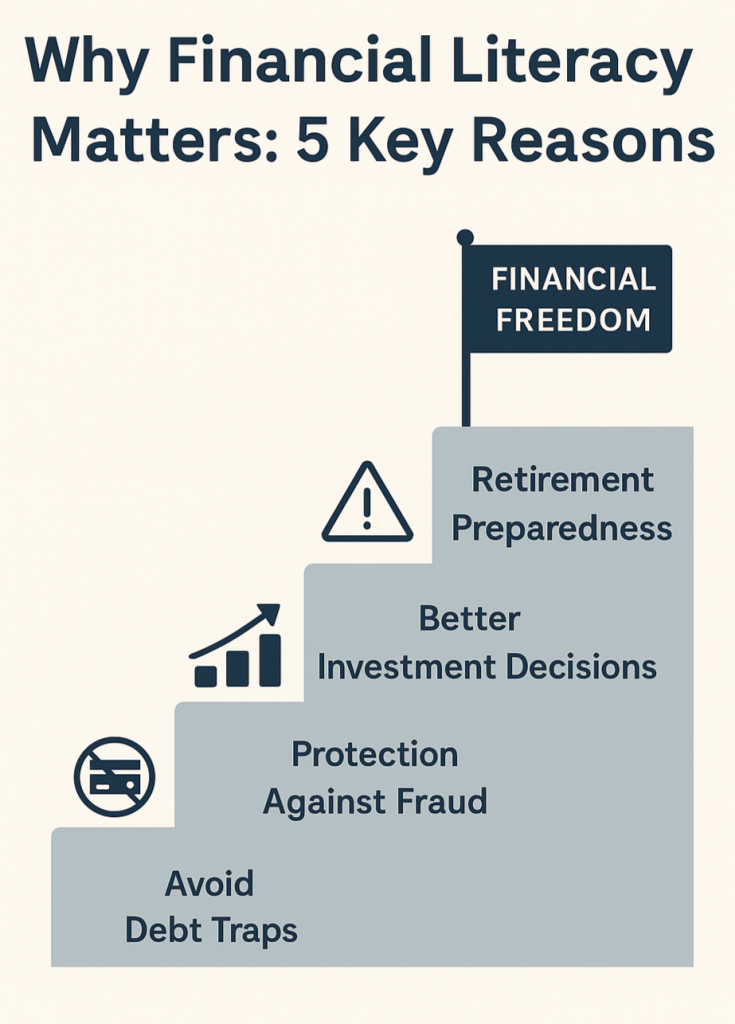Master Your Money, Build Wealth, and Achieve Financial Freedom
Introduction
In today’s fast-paced world, managing your money wisely is no longer optional—it’s essential. Whether you’re just starting your career, planning your child’s education, or dreaming of a comfortable retirement, personal finance is the foundation of every financial goal.
Unfortunately, financial literacy remains low in India, and many people fall into the trap of living paycheck to paycheck, investing blindly, or not investing at all. This comprehensive guide will help you take control of your money, make smarter financial decisions, and move closer to financial freedom.
By the end of this guide, you’ll know how to:
✅ Set clear financial goals
✅ Budget and save effectively
✅ Invest smartly in mutual funds, stocks, and other assets
✅ Protect your wealth through insurance and tax planning
✅ Build passive income streams for long-term security
1️⃣ What is Personal Finance?
Personal finance refers to how you manage your money as an individual or family. It covers everything from earning, saving, and spending to investing, insuring, and planning for retirement.
Personal finance isn’t just about how much you earn—it’s about how you manage and grow what you earn.
📌 Key Components of Personal Finance:
Retirement Planning: Securing your financial independence in later years. Begin your journey toward wealth and wisdom.
Income: Your salary, business profits, side hustles.
Expenses: Essential costs (rent, food) and non-essential spending.
Saving: Emergency funds, short-term goals.
Investing: Growing wealth through mutual funds, stocks, fixed income, etc.
Insurance: Protecting yourself and your family.
💡 Why Does Personal Finance Matter?
- Without control over your money, you risk falling into debt, living paycheck to paycheck, or having an uncertain retirement.
- Financial planning gives you the power to achieve freedom, security, and peace of mind.
✅ Quick Example:
Imagine saving just ₹100 per day in a mutual fund SIP—this small step can grow to ₹1 Crore over time thanks to the power of compounding.
2️⃣ Why is Financial Literacy Important?
In India, many people grow up without formal education on managing money. As a result, even highly educated professionals sometimes make poor financial decisions—overspending, under-investing, or falling into debt traps.
One of the easiest ways to improve your financial literacy is by learning the basics of Mutual Funds—one of the most popular and accessible investment tools in India.
📊 Key Reasons Why Financial Literacy Matters:
Financial Freedom:
When your money works for you (through investments and passive income), you gain the freedom to live life on your own terms.
Avoid Debt Traps:
Understanding how loans, credit cards, and EMIs work can prevent you from falling into endless cycles of debt.
Better Investment Decisions:
Knowing the difference between saving and investing helps you grow your wealth instead of letting it sit idle. You can explore whether it’s possible to succeed in stock market investing without any knowledge, a question many new investors grapple with.
Protection Against Fraud:
Being financially informed protects you from scams, high-cost insurance products, and get-rich-quick schemes.
Retirement Preparedness:
With no formal pension for most Indians, you must create your own financial safety net.

3️⃣ Setting SMART Financial Goals
One of the biggest reasons people struggle with money is not having clear financial goals. Without a destination, it’s impossible to create a roadmap to financial success.
That’s where SMART goals come in—a simple but powerful framework to help you define your financial aspirations in a way that is Specific, Measurable, Achievable, Relevant, and Time-bound.
You can see a real-life example of SMART financial planning in action in this post: Saving ₹100 a Day Can Create ₹1 Crore Wealth, which shows how small daily savings, when structured with discipline, can lead to massive wealth over time.
What Are SMART Financial Goals?
| Letter | Meaning | Example |
|---|---|---|
| S | Specific | “I want to save ₹5 lakhs for my child’s education” |
| M | Measurable | Track how much you save each month towards this goal |
| A | Achievable | Ensure the goal fits your income and expenses reality |
| R | Relevant | It aligns with your personal values and priorities |
| T | Time-bound | Set a clear deadline: “By March 2028” |
🎯 Examples of SMART Financial Goals:
✅ Short-Term Goals (1–3 years):
- Save ₹1 lakh for an emergency fund.
- Pay off a ₹50,000 credit card debt in 12 months.
✅ Medium-Term Goals (3–7 years):
- Save ₹10 lakhs for a home down payment.
- Build a ₹5 lakh mutual fund portfolio.
✅ Long-Term Goals (7+ years):
- Accumulate ₹1 crore for retirement.
- Build passive income of ₹25,000/month.
💡 How to Set Your SMART Goals:
- List your life priorities: (Home, education, retirement, travel)
- Assign numbers: (How much money do you need for each?)
- Set deadlines: (By when?)
- Break into action steps: (Monthly savings, SIPs, etc.)
- Review annually: (Are you on track?)
For example, when selecting the right mix of mutual funds, it’s important to align your choices with your life stage and risk tolerance. This post on Selecting the Right Mix of Mutual Funds explains how asset allocation supports goal-based investing.
🚀 Why SMART Goals Matter:
- They bring clarity and motivation.
- They help you track progress.
- They make your financial dreams achievable instead of vague wishes.
4️⃣ Budgeting: The Foundation of Wealth
No matter how much you earn, if you don’t know where your money is going, wealth will always remain out of reach. Budgeting is the bedrock of personal finance—it’s the first step towards taking control of your money and building lasting wealth.
💡 What is Budgeting?
A budget is simply a plan that helps you:
- Track your income and expenses
- Control overspending
- Prioritize saving and investing
- Achieve your financial goals faster
Without a budget, most people tend to spend first and save whatever is left—which often leads to little or no savings at all.
The 50/30/20 Rule: A Simple Budgeting Formula
One of the easiest ways to start budgeting is the 50/30/20 Rule:
| Category | Percentage of Income | Example (₹50,000 Monthly Income) |
|---|---|---|
| Needs | 50% | ₹25,000 (rent, food, bills) |
| Wants | 30% | ₹15,000 (entertainment, shopping) |
| Savings & Debt Repayment | 20% | ₹10,000 (SIP, emergency fund, loans) |
👉 Tip: You can adjust these percentages based on your goals. For example, if you aim for financial independence, you may want to save 30% or more.
How to Create Your Budget (Step-by-Step):
- Calculate Your Monthly Income (after tax)
- List Your Fixed Expenses (rent, EMIs, utilities)
- List Your Variable Expenses (food, shopping, travel)
- Set Savings & Investment Targets (SIP, emergency fund, etc.)
- Track Monthly and Adjust as life changes
Why Budgeting Matters:
✅ Helps you live within your means
✅ Ensures consistent saving and investing
✅ Reduces financial stress and anxiety
✅ Keeps you on track to achieve SMART goals (from Section 3)
Recommended Reading:
If you’re ready to take the next step, check out this detailed guide on Saving ₹100 a Day to Build ₹1 Crore, which shows how even modest, consistent savings can lead to massive wealth.
Pro Tip:
Offer a Free Budget Template (Excel/PDF) as a downloadable resource on this section.
5️⃣ Saving vs Investing: Know the Difference
One of the most common mistakes people make on their personal finance journey is confusing saving with investing. While both are essential, they serve very different purposes in building wealth.
💰 What is Saving?
Saving means setting aside money in safe, liquid, low-risk instruments for short-term needs or emergencies.
Examples include:
- Bank Savings Accounts
- Fixed Deposits (FDs)
- Recurring Deposits (RDs)
Key features of saving:
✅ Safety of capital
✅ Low or no risk
✅ Lower returns (often below inflation)
Saving is not meant for wealth creation but for:
- Emergency funds
- Short-term expenses
- Stability
📈 What is Investing?
Investing involves putting your money into assets that can grow over time but carry some level of risk.
Examples include:
- Mutual Funds (Equity, Debt, Index)
- Stocks
- Gold
- Real Estate
Key features of investing:
✅ Potential for higher returns
✅ Risk of market ups and downs
✅ Helps beat inflation and build wealth
Investing is for:
- Long-term goals (5+ years)
- Wealth creation
- Retirement planning
🔑 How They Work Together:
| Purpose | Saving | Investing |
|---|---|---|
| Time Horizon | Short-term (0–3 years) | Long-term (3+ years) |
| Risk | Low | Moderate to High |
| Returns | 3–6% (fixed) | 10%+ (variable, average) |
| Liquidity | High (easy access) | Medium to Low (market-dependent) |
Both saving and investing are like two sides of the same coin—you need saving for security and investing for growth.
📌 Suggested Actions:
- Build an emergency fund first (at least 3–6 months’ expenses).
- Start investing early—even ₹100/day SIPs can grow into crores over time.
- Don’t let all your money sit idle in a savings account.
🔗 Related Reading:
6️⃣ Asset Allocation & Risk Management
Once you start saving and investing, the next key to building long-term wealth is learning the art of Asset Allocation—the strategy of spreading your investments across different asset classes to balance risk and reward.
Asset allocation is what protects your wealth when markets are volatile and ensures that you don’t put all your eggs in one basket.
🧩 What is Asset Allocation?
Asset Allocation means dividing your investments across:
- Equity (Stocks, Mutual Funds)
- Debt (Bonds, Fixed Income, PPF)
- Gold & Commodities
- Real Estate
- Cash & Liquid Funds
📊 Why is Asset Allocation Important?
✅ Reduces the risk of big losses when one asset class underperforms
✅ Helps you stay invested during market ups and downs
✅ Increases the chance of stable, long-term returns
Studies show that 90% of portfolio performance depends on asset allocation—not on picking the best stocks or funds.
🔑 Age-Based Asset Allocation (Rule of Thumb):
One of the simplest ways to decide your asset mix is the “100 Minus Age” Rule:
| Age | Suggested Equity % | Debt + Others % |
|---|---|---|
| 25 | 75% Equity | 25% Debt |
| 35 | 65% Equity | 35% Debt |
| 45 | 55% Equity | 45% Debt |
| 55 | 45% Equity | 55% Debt |
As you grow older or approach financial goals, you should gradually shift towards safer assets.
📌 Risk Management Tips:
- Diversify across multiple assets, sectors, and geographies.
- Don’t chase returns blindly—focus on balanced growth.
- Regularly review and rebalance your portfolio every 6–12 months.
📝 Real-Life Example:
A 30-year-old investor could follow this asset allocation:
- Equity Mutual Funds: 70%
- Debt (PPF, Bonds, Liquid Funds): 20%
- Gold/Commodities: 5%
- Cash/Liquid: 5%
🔗 Related Reading:
7️⃣ Building Wealth Through Mutual Funds
When it comes to personal finance and wealth creation, one of the most popular and powerful tools available to every investor is the mutual fund. Mutual funds have become the backbone of modern personal finance strategies in India, helping millions of people grow their wealth systematically.
💡 What are Mutual Funds?
A mutual fund is an investment vehicle where money from multiple investors is pooled together and invested in a diversified portfolio of:
- Stocks (Equity Mutual Funds)
- Bonds (Debt Mutual Funds)
- Gold (Gold ETFs)
- Other assets
Professional fund managers manage these funds, making investment decisions on behalf of investors.
Mutual funds play a central role in personal finance because they offer accessibility, diversification, and potential for higher returns.
📈 Why Choose Mutual Funds in Your Personal Finance Plan?
✅ Affordable: Start with as little as ₹100 through SIPs (Systematic Investment Plans)
✅ Diversified: Reduces risk by spreading investments across many assets
✅ Expert-Managed: Ideal for people new to personal finance who may not have time to pick individual stocks
✅ Goal-Linked: Whether it’s retirement, buying a house, or children’s education—mutual funds fit every personal finance goal.
🔑 Types of Mutual Funds in Personal Finance:
| Fund Type | Key Features | Suitable For |
|---|---|---|
| Equity Mutual Funds | High growth, high risk | Long-term wealth building |
| Debt Mutual Funds | Steady income, lower risk | Capital preservation, stability |
| Hybrid Funds | Mix of equity & debt | Balanced approach |
| Index Funds | Passive, low-cost investing | Beginners & low-cost seekers |
| ELSS (Tax-Saving) | Equity fund with tax benefits under 80C | Tax planning in personal finance |
🚀 Power of SIPs: A Personal Finance Game-Changer
A Systematic Investment Plan (SIP) is the most beginner-friendly method to invest in mutual funds. It aligns perfectly with personal finance principles by:
- Encouraging discipline
- Allowing small monthly contributions
- Taking advantage of Rupee Cost Averaging
👉 For example:
Investing ₹100 per day through SIP can potentially create ₹1 Crore in the long term. (Read the full article: Saving ₹100 a Day to ₹1 Crore Wealth)
📝 How to Choose Mutual Funds for Personal Finance Goals:
- Define your financial goal (short-term vs. long-term)
- Know your risk appetite
- Use platforms like Zerodha Coin, Groww, INDmoney to invest easily
- Track and review regularly
This approach integrates seamlessly into a personal finance plan that is goal-driven and future-ready.
🔗 Related Personal Finance Reading:
🛠 Recommended Platforms to Start Your Personal Finance Journey
To kickstart your personal finance and investment journey, here are some of the most trusted platforms I personally use and recommend:
✅ Zerodha — India’s largest discount broker, perfect for stocks, mutual funds, and SIPs. (Low brokerage, user-friendly platform)
✅ Upstox — Another fast-growing broker with great mobile trading and investment options.
✅ FundsIndia — Ideal for beginners who want to invest in mutual funds online with expert recommendations.
👉 Open your account today and take the first step toward building wealth and financial freedom.
🚧 More Personal Finance Topics Coming Soon!
We’re constantly working to bring you the most practical and actionable personal finance insights. Stay tuned as we add more powerful sections to this guide, including:
- 8️⃣ Passive Income Strategies in India
Learn how to create multiple income streams to achieve financial freedom. - 9️⃣ Tax Planning & Saving Tips
Simple legal ways to save taxes and keep more of what you earn. - 🔟 Insurance: Your Financial Safety Net
Understand why insurance is essential for every solid personal finance plan. - 1️⃣1️⃣ Retirement Planning: Securing Your Future
How to build a retirement corpus that lets you live life on your own terms. - 1️⃣2️⃣ Common Money Mistakes to Avoid
Identify and avoid costly mistakes that could derail your wealth journey. - 1️⃣3️⃣ Top Resources & Tools for Financial Success
Discover the best apps, books, and tools to level up your personal finance game.
✅ Bookmark this page or subscribe to our newsletter so you never miss an update!



Pingback: NSDL IPO 2025: 7 Must-Know Insights Before You Invest in India’s Financial Backbone - Wealthy Wisdom
Pingback: Best Index Funds Returns in India 2025: A Complete Guide - Wealthy Wisdom